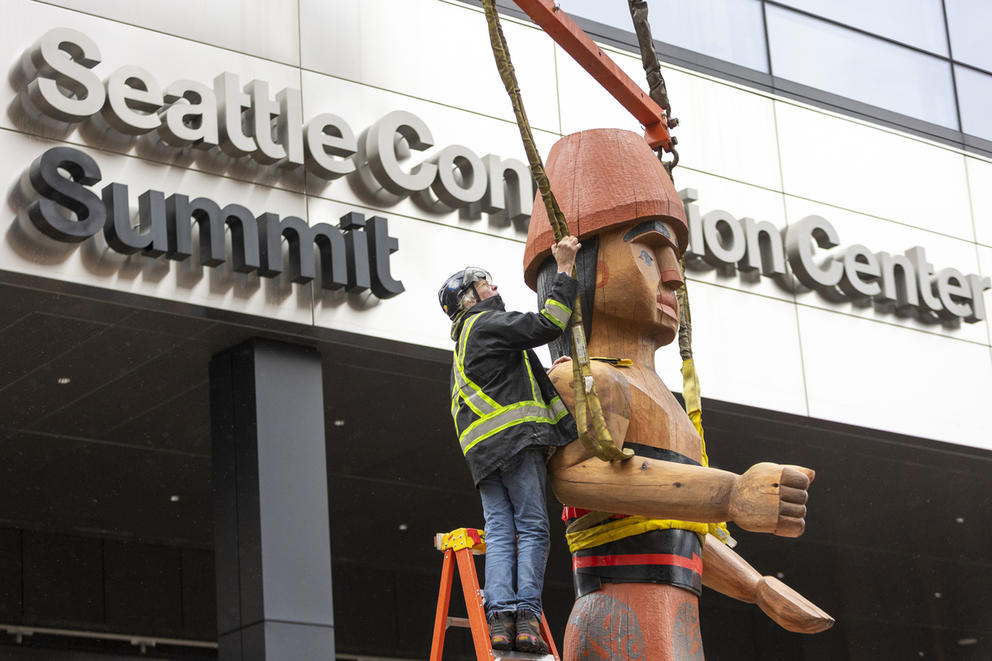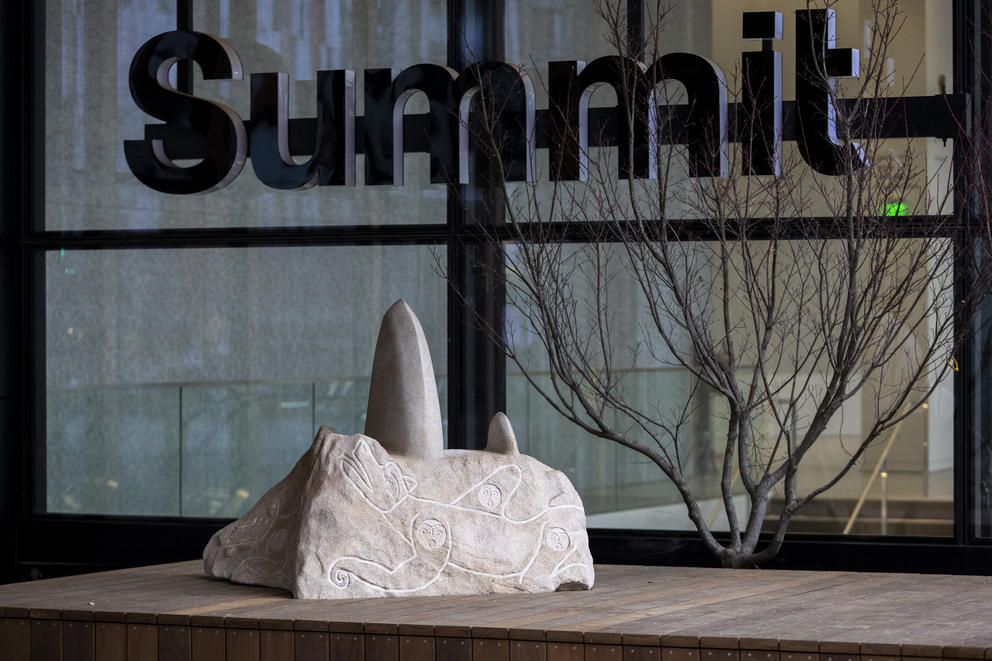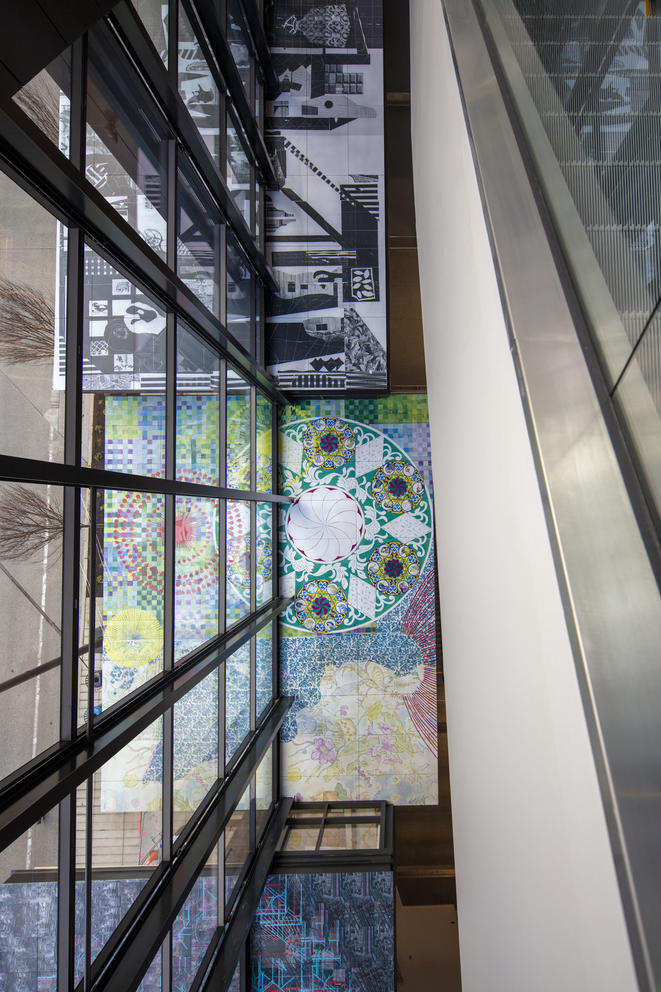Broad-shouldered and stocky, “Mowitch Man” is a welcome figure, a type of statue traditionally made by Coast Salish people to invite visitors into their territories. As the rain continues to fall, Wilbur-Sigo gestures to the sculpture’s cedar skin, black hair, vermillion hat and regalia adorned with gray Salish-style salmon emblems. “He matches the building really well,” she says.
Starting this week, Wilbur-Sigo’s “Mowitch Man” will welcome the first visitors to Seattle’s brand-new and highly anticipated addition to the Washington State Convention Center (rebranded as the Seattle Convention Center). Called the “Summit,” the six-story hub is meant to expand the existing convention center’s physical and economic footprint.
Spanning more than 500,000 square feet of meeting and event space and costing $2 billion, the project, designed by local firm LMN Architects, is one of the largest and most expensive in Seattle’s history. It is funded in large part by King County’s lodging tax. (In the coming years, the project will also add nearly a million square feet of residential and office space to the convention center.)
The high-rise metal- and glass-clad building opens this week after four years of construction and more than a decade of planning, with a ribbon-cutting ceremony (Jan. 25) and public open house (Jan. 27).
The Seattle Convention Center Summit Building, designed by LMN Architects, sits at the intersection of the Capitol Hill, First Hill and Downtown neighborhoods. Large windows offer views of the city skyline from various angles, a departure from the more typical "closed box" architecture of many convention centers. “You know that you’re here when you’re at a convention in this building, not in Dallas or wherever,” says Kate Westbrook, a principal at LMN Architects. “You’re in Seattle and you feel that energy.” (Courtesy of Adam Hunter/LMN Architects)
Whether it’s the costumed crowd that flocks to the Emerald City Comic Con (expected attendance: 25,000), the literati attending the AWP Conference & Bookfair (10,000) or attendees of the Association of American Medical Colleges’ annual meeting (4,000), one of the first things people will encounter upon approaching the building is Northwest art.
From 16-foot-tall wooden welcome figures and original bronze sculptures to intricate laser-cut garage doors and other creative architectural elements, the building and its street-level surroundings brim with art by nearly two dozen, largely local, artists. Total price tag: $7.75 million.
Unlike Seattle’s other percent-for-art projects, the Seattle Convention Center’s public-art program funding doesn’t entirely stem from a legally mandated percentage of the construction budget. Rather, it’s part of a set of agreements with the city and county requiring that the Convention Center, a self-governing Public Facilities District, provide “public benefits” like affordable housing and public art.
But the art is there for an additional reason, says Cath Brunner, the Convention Center’s art consultant: to showcase the best of the Northwest and the diversity of its communities and natural beauty. As part of the overarching plan to imbue the building with a strong sense of place, a large percentage of the art is made by Indigenous artists and engages with the history of the land the building sits on.
“I think of it as being very specific to our place,” Brunner says of the Convention Center’s design. “You really feel like you're in the city. And that's what we wanted to do with the art too. You can really feel the sense of place and why we all think it’s really special.”
On this day, a week ahead of the ribbon-cutting, construction workers in yellow vests move in and around the building, still finalizing design details. Not all artworks are in place yet; they’ll continue to be installed over the coming months. But there’s enough art for a tour with Brunner, which we embark on just as the rain lets up.
On the public plaza, Wilbur-Sigo’s “Mowitch Man” now stands firmly footed in his base. The rain has awakened the fresh woodsy smell of the pine used as decking and platforms on the plaza, which will also function as outdoor seating for restaurants housed on the Convention Center’s street level. When all artworks are installed, it will also be home to four pieces by local Indigenous artists, all women.
Brunner, in collaboration with artists/curators Norie Sato and Asia Tail, envisioned the art on this public plaza as a visual form of land acknowledgment. “So there’s no doubt in your mind that we are on Indigenous land — the traditional territories of the Coast Salish people,” Brunner says.
These artworks, while disparate, all connect with their surroundings in various ways. Wilbur-Sigo’s “Mowitch Man” faces west, down Pine Street toward Elliott Bay. “We will always be the people of the water,” Wilbur-Sigo says. “Even living in a big city, having all these big buildings, we’re still people of the water — that’s what connects all of us.”
This theme returns in We Are All Connected, a series of sandstone boulders carved with contemporary petroglyphs of coyotes, stars, thunderbirds and spirits. Made from Northwest sandstone by local artist Malynn Foster (Squaxin Island and Skokomish Nations), who worked with both traditional and pneumatic hammers and chisels, the stone sculptures sit surrounded by native plants and a copse of shore pines in the brand-new landscaping.
Two dorsal fins breach from one of the stone sculptures positioned near the row of heavy entrance doors. Titled “17 Days We Wake Up the World,” the work references the 17 days that the orca Tahlequah carried her deceased calf through the waters of the Salish Sea in 2018. By sharing Tahlequah’s story, Foster hopes to wake up the world to the effects of the dwindling local salmon populations.
Andrea M. Wilbur-Sigo, a renowned local artist and member of the Squaxin Island Tribe (at left in hard hat) and husband Steve Sigo embrace as workers install “Mowitch Man,” one of the two Salish welcome figures Wilbur-Sigo carved for the Seattle Convention Center addition. (Jason Redmond for Crosscut)
“Mowitch Man” and Foster’s boulders will soon be joined by more artworks. Later this year, the staircase leading up to Pine Street will be cocooned by a corten steel sculptural stairway enclosure designed in the shape of a burden basket by local artist and architectural designer Kimberly Deriana (Mandan and Hidatsa).
By the beginning of March, another artwork will be added to the wooden podium flanking the stairs: four masks made of cast bronze, steel, and cast glass. Designed by Jennifer Angaiak Wood (Yup'ik), the sculptures are an homage to Alaska Native groups and their connections with Pacific Northwest tribes. “I wanted to try to Indigenize a public space, not just with artwork, but also with the understanding that these pieces are likely to be touched,” Wood wrote in an email. “Masks historically are meant to be handled.”
The Convention Center masks are Wood’s first major public artwork. “I think one of the most special aspects of the selection process for this project is that the artists invited to apply weren't required to have public-art experience,” Wood noted in her email. “Instead of seeing a lack of experience as a reason to exclude an artist, the art committee and coordinator went to great lengths to encourage each of us to embrace the experience.”
Wood isn’t alone: Many of the Convention Center artists had never done a large-scale public project before — and now their work will be seen by thousands of visitors a month.
Making sure first-time public artists felt technically and financially supported was intentional, Brunner says. This approach resulted in a high percentage of first-time public projects, as well as a diverse set of artists, the majority of whom are people of color.
Another way to convince first-time public artists to throw their hat in the ring: opening submissions to 2D artwork. For painters and photographers, that meant their work could be digitized and then printed on panels that became part of the architecture.
In collaboration with the architects, the art team commissioned four local artists — Satpreet Kahlon, Ulises Mariscal, Maki Tamura and Robert Hardgrave — to create a series of art panels to cover interior and exterior walls on the street level. These durable powder-coated aluminum panels are designed to stand the test of time (and Seattle rain).
Holding a “talking stick,” Andrea Wilbur-Sigo's "Mowitch Man" will welcome visitors to Seattle's new convention center extension. He’ll also lend an ear to anyone who needs to get something off their chest or share some good news, Wilbur-Sigo says. “You’re having a bad day? Just go sit with them,” she says of her welcome figures. “Go think. Talk, if you have to. They will take any of that badness, or that goodness, and …. hopefully, leave you in a place that you walk away feeling good.” (Jason Redmond for Crosscut)
Tamura and Hardgrave each opted to pay homage to Seattle’s energy. While Hardgrave represents the “vitality of the city” with black and white shapes in his signature neo-naive collage style, Tamura’s panels are all color: Red ribbons fall from a sky full of watercolor streaks and splotches of purple, yellow and blue. A series of medieval figurines fight and fly and jump, creating a joyful and kaleidoscopic circus vibe.
“My inspiration came directly from everyday experiences — walking from Capitol Hill to Downtown, meandering through the busy traffic, finding joy in the colors of the sky and water, peeking into fun shops and public art dotted throughout the urban core,” Tamura wrote in an email. “I tapped into my memory and experiences of living in Seattle that is not just gray and rainy!”
Also tapping into the past is Ulises Mariscal, whose panels honor the time when the Summit was just a construction crater peppered with cranes. Mariscal took photos of the site as workers poured concrete and built its foundations. He then rearranged these photos into a black-and-white collage, which he painted over with colorful lines that nod to the location’s former status as a Metro bus hub.
“I find it beautiful seeing all [these] construction workers coming together from all over the place to create something meaningful and important,” says Mariscal, who immigrated here from Mexico 16 years ago.
The fourth metal-paneled artwork spans a whole wall inside another entry hall. As we peer through the doors, we see the wall glow with splendid purples and blues — the BIV of the ROYGBIV spectrum. Satpreet Kahlon created the design four years ago right here, when, with the building still under construction, they sat down on the sidewalk, opened a scanner without its cover and scanned the sky.
“The purpose of this exercise was to capture a specific quality of sunlight — the precise way that the sun has been hitting this small patch of earth and land for millennia,” Kahlon wrote in an artist statement.
As we continue our tour around the building’s perimeter, we encounter a series of artworks you might miss at first. Integrated into the facade as oval metal wall hangings and including functional elements like swiveling seats and a garage door, Walktic, by local artist Sheila Klein, is at one with the urban environment.
“You’ll have to pay attention as you walk by. There’s an optical effect that happens that makes these seem like kinetic sculptures,” Brunner says. “It's a piece designed to be appreciated in motion.” (I tested this by running a short distance, and they do come alive, like a Vasarely painting.)
In some cases, seeing the art may depend less on your own speed than on mechanical timing. Based on one of her paper-cut drawings, artist Lauren Iida designed a garage door that takes the shape of a water-cut steel latticework of foliage, flowers, clams and squids, fish and apples. But this Pacific Northwest bounty is fully visible only when closed, so prepare for a game of peekaboo.
Just a few feet west on Olive Way sits the building’s second main entry. Here another welcome figure is waiting for us: Wilbur-Sigo’s 16-foot-tall “Creator,” a pregnant woman with a baby on her back. Still to come are another petroglyph sculpture from Malynn Foster and a large-scale weaving by local artist Danielle Morsette (Suquamish and Sto:lo) inside the vestibule. And, by this summer, there will be a collaborative artwork made by all five Indigenous artists.
We step inside the dim hallway that connects the two entrances. Soft light cascades from the wooden latticework chandelier. Called “A Place in the Woods” and existing somewhere on the continuum between art and functional design, the chandelier was designed by artist Cathy McClure in collaboration with LMN. Forty-five strategically placed perforated wooden panels — their patterns modeled after the leaves, bark and roots of 13 Pacific Northwest native trees as seen through a microscope — give the sense of sun dappling through a tree canopy.
Moving from the street-level floors to the top, you’ll find fewer artworks; the designers wanted to leave more blank walls for convention guests’ own signage and displays. But the use of local wood like madrona (in the giant staircase that ziggurats through the building), reclaimed “wormwood” and other details continue to drive the PNW point home.
Still, the main attention-grabbers here are the skyline and, in the distance, the natural beauty of the mountains and water visible through the many windows.
“One of the magic qualities about this building is how you get glimpses and views, and how you move through it almost like an unfolding journey; you see something from afar, then you see it close up,” Brunner says as we walk toward a platform framed by tall windows facing west.
Right then, the lights of the Paramount’s iconic marquee and vertical neon sign — visible from inside through the windows — power up as the afternoon sky starts to darken.
By the end of the year, a new sculpture by Seattle artist Dan Webb will stand here, with a view that looks out toward the Pike Place Market sign and, a bit farther, Puget Sound. It’s fitting: Webb’s sculpture takes as inspiration Seattle’s iconic marquees and signs, like those of the Pike Place Market and Elephant Car Wash.
Webb’s 20-foot-tall stained glass window will take the shape of a pointing hand and bench. Echoing the material of the nearby stairs, Webb is carving the hand from local madrona wood.
“The work I make has really responded to the people, the water, the trees, and the culture of the Northwest,” Webb wrote in an email, “and that goes for the convention center [artwork] too.” He’s naming it “Right Here.”
This story has been updated to clarify the convention center addition’s funding source, which comes in large part from King County’s lodging tax.
Get the latest in local arts and culture
This weekly newsletter brings arts news and cultural events straight to your inbox.














